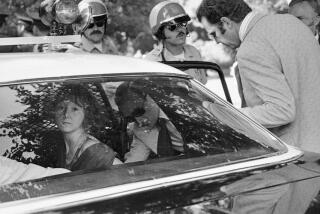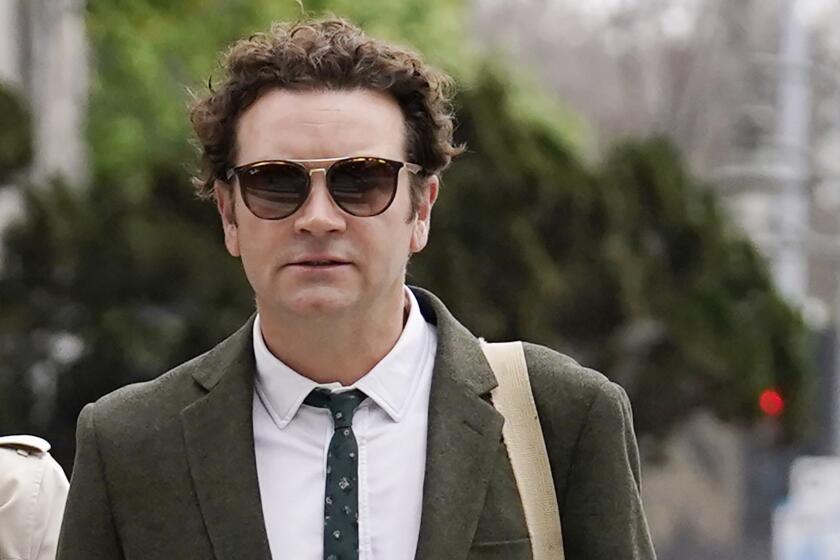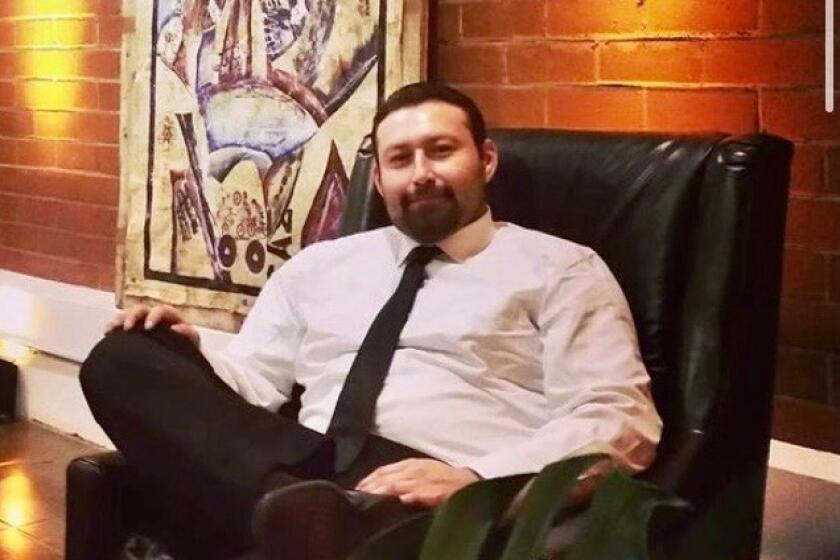KEEPING MANSON BEHIND BARS : Prosecutor Stephen Kay Still Fights to Make Sure the Evil of the Tate-LaBianca Murders Is Never Forgotten
THE MOST superfluous traffic sign in California is the one on the short spur road that winds along the bay front to the state penitentiary at San Quentin. The sign says “NOT A THROUGH STREET.”
On a February morning of record-low 32-degree chill, Stephen Kay, a tall, deaconish Los Angeles County deputy district attorney, drives past the sign and parks at the road’s windswept end. A body search completed, Kay is escorted to a prison conference room. He has a few minutes to arrange his papers for the latest in nearly 20 years of confrontations with Charles Milles Manson, mastermind of the peculiarly unforgettable mass murders that badly rattled California in August of 1969.
The morning’s legal conflict promises to be one-sided. Manson, led from his single cell in San Quentin’s Security Housing Unit, has waived his right to an attorney. He is long past trying to ingratiate himself with the three-man Board of Prison Terms panel that will decide whether to grant him a future parole date. Now 54, his flying beard going to gray, the 5-foot-2 life-termer has the shrunken, unkempt appearance of a Death Valley hermit, which is precisely what he has said he would like to be if ever released.
Manson reaches the door behind which the hearing officers and Kay wait with two “pool” reporters and two television cameras. The Tate-LaBianca killings are still news. New American Library late this year is publishing an updated edition of Ed Sanders’ 1972 book, “The Family: The Story of Charles Manson’s Dune Buggy Attack Battalion.” The proceedings are being wired to a guardroom where 25 reporters and TV news technicians hover, hoping Charlie will say something suitably Mephistophelean.
He often does. At the Vacaville facility in 1981, Manson warned Kay that he would be killed in the parking lot after the hearing. At Manson’s 1986 evaluation, Kay asked why Manson spends hours in his cell constructing scorpions out of thread from his socks. Manson, the razor-sliced swastika in his forehead emphasized in blue-black ink, took the bait. “From the world of darkness I did loose demons and devils in the power of scorpions to torment,” he announced. That unremorseful response was good, Kay triumphantly thought, for another three-year parole denial. He was right.
This year, a moment before he is to enter the hearing room, Manson abruptly decides that he is having none of this legally mandated but manifestly futile ritual. His wrists are being clamped into manacles in the normal procedure when he protests, “They’ll think I’m dangerous!” He refuses the restraints and demands to return to his cell.
With Manson in absentia for the third time in his nine hearings, Stephen Kay, a 22-year veteran at the D.A.’s office, begins his 38th argument against parole for the five people convicted of murdering Sharon Tate and the six other victims. Kay has been making these arguments for 11 years, ever since Manson, Susan (Sadie Mae Glutz) Atkins, Charles (Tex) Watson, Patricia (Katie) Krenwinkel and Leslie Van Houten first became eligible for parole.
“The Tate-LaBianca case had all the good things and bad things of the ‘60s,” says Ed Sanders, the Woodstock, N.Y., poet and author. “It had sex and murder, life styles, counterculture, Hollywood, rock ‘n’ roll stars like Dennis Wilson--everything that makes for a circus. The trial was a combination of fascination and revulsion, like a snake with its tail in its mouth. It just kept rolling along, this revulsive snake. It’s still rolling along.”
SHARON TATE WAS 26, a classically beautiful but not quite top-rank movie actress eight and a half months pregnant, when a dark-clad band on a mission from Manson invaded the Benedict Canyon estate she and her film-director husband, Roman Polanski, were renting. The ensuing predawn horror of Aug. 9 was not without its complex of motives--a fusion of the Beatles, the Bible and plain old resentment. A previous tenant there, Terry Melcher, the record-producer son of actress Doris Day, had snubbed Manson and his musical ambitions a year earlier. Sharon Tate and four visitors to the secluded hilltop were slaughtered, as Atkins told a grand jury, “to instill fear into the Establishment.”
The following night, after the sensational celebrity murders failed to trigger the black-white race war Manson had prophesied from his dark reading of Revelations and the Beatles’ “Helter Skelter” during long group LSD sessions, Manson himself entered the Los Feliz home of Leno LaBianca, owner of a small supermarket chain. He tied up LaBianca and his wife, Rosemary, then left them to die at the hands of three demonic disciples, who carved away with knives and forks from the LaBianca kitchen.
Prominent as some of the victims were, Manson immediately surpassed them in public interest. Kay recalls, “With his picture on the cover of Life magazine--that stare--Manson was like everybody’s Freddy.” Here was a man, prefiguring Jim Jones in the Guyana jungle, with the mysterious power to command others to kill for him, even to dispatch themselves to the gas chamber by taking all the blame at trial and attempting to exculpate the leader they sincerely regarded as both Jesus and the devil.
Many mass- and serial-murder cases since then have involved greater numbers of deaths--24 in the case of Juan Corona, for example. What set the Tate-LaBianca murders apart and made them particularly frightening was that the killers included young women, mainly from peaceable middle-class backgrounds (Leslie Van Houten had been a Homecoming princess at Monrovia High School). “Better lock your doors and watch your own kids,” Susan Atkins eerily warned the jury that convicted her.
“That was the end of the ‘60s for a lot of people in L.A.,” recalls Joan Didion, whose deal to write a book with star prosecution witness Linda Kasabian went awry. “It was a period when there seemed to be a lot of possibilities, good and bad. People were getting very nervous around that time. There was just a lot of stuff going on. Anything could happen. . . . I mean, it was everybody’s nightmare.”
NOTORIOUS CASES may fade from the headlines, but they continue testing the legal system and its entanglements with politics for decades. Manson has effectively surrendered, but the others are fighting seriously for freedom, using skilled lawyers. For these convicts and Kay, all in middle age now, the combat over the evil of that distant summer has never really ended.
Kay’s side--the mocked “straight” society perfectly embodied in Kay’s conservative vested pinstripes and gold collar pin--has won almost every time. The social rebellion of the ‘60s was carried to a horrible extreme in the depredations of Manson and his dropout “family” of acid habituees. The Tate-LaBianca carnage was, as Sanders says, “the death of hippie.” Outraged middle-class values have reasserted themselves, quite literally with a vengeance, ever since.
Juries in the nine-month 1970-71 trial of Manson and the three “Manson girls” and in Watson’s separate trial asked for vengeance in condemning them to death for first-degree murder and conspiracy. In 1972, the California Supreme Court invalidated the existing capital punishment statute. By operation of law, the sentences were commuted to indeterminate terms ranging up to life. This has been the defendants’ only victory. Since 1978, they have been eligible for parole. They remain in prison.
The leading voice for unforgetting retribution has belonged to Stephen Kay, a nonsmoking, nondrinking, nonswearing Presbyterian church elder, youth soccer coach and father of three sports-minded suburban teen-agers. His role, largely self-appointed and not without criticism, has been to demand continuing punishment--with little or no allowance for personal rehabilitation--for those gunshots in the canyon, for the pagan smearing of PIGS and the illiterate HEALTER SKELTER on the walls of the wealthy in their own blood.
If Kay continues to have his way, officials in a complex parole system that on occasion has been politically insensitive will think very carefully before letting any of the Tate-LaBianca murderers, however self-improved, out of jail.
Kay says he handled “even more gruesome” murder cases in 14 years as a trial prosecutor, notably the 1980-81 trial of Lawrence Bittaker, who with a companion taped the prolonged torture of one of five teen-age girls they kidnaped. Kay considers Manson’s murders worse, different in kind.
“The reason I’m on the tail of all these people and I won’t let up on them,” Kay explains, “is that they wanted to destroy society in a race war and have hundreds of thousands of innocent people murdered. Sure, it was unrealistic, but they tried to have it happen.”
Kay mistrusts the parole machinery and wants to keep a public spotlight on its workings. “I can see that the system has not worked perfectly,” Kay says, “because Sirhan Sirhan was given a parole date.” The assassin of Robert F. Kennedy was told in 1975 that he would be freed in 1984; a public outcry forced a rescission of parole in 1982. Other unpopular parole approvals prompted the passage of Proposition 89 last November, allowing the governor to overrule the Board of Prison Terms and revoke a parole date.
Of the eight Manson “family” members convicted in the nine murders that law enforcement was able to establish, only one, Steve (Clem Tufts) Grogan, has been paroled. Grogan, convicted in the killing of a cowboy named Donald (Shorty) Shea, has been quietly painting houses in the San Fernando Valley since 1985 after serving 13 years. He profited from showing the authorities where Shea’s previously undiscovered remains were buried near the Spahn Ranch, Manson’s dusty Chatsworth base. Kay had no part in the bartering. At the parole hearing, the board was influenced by a letter from Superior Judge Burton Katz, who had prosecuted the case and praised Grogan’s later cooperation.
AT SAN QUENTIN, a month before Manson is transferred to the new maximum-security Corcoran facility in the San Joaquin Valley, Kay’s argument runs 27 minutes. He re-tells the old crimes in a painstaking detail that revives the months of widespread fear before the killers were identified through Atkins’ euphoric blabbering to two Sybil Brand Institute cellmates. Atkins, Manson and 22 others coincidentally had been rounded up in mid-October at their Death Valley retreat and booked for unrelated arson and auto thefts. Atkins was placed in Sybil Brand as a suspect in the Malibu torture-murder of musician Gary Hinman a few days before the Tate-LaBianca slayings. “Wow, what a trip!” she blurted out to a fellow prisoner about tasting Sharon Tate’s blood. After more investigation, Los Angeles Police Chief Ed Davis announced on Dec. 1 that the case was solved.
Kay’s tone is subtly impatient, still unforgiving about the need to go through these statutory parole considerations. If, as some of his opponents suggest, Kay is simply seeking publicity, he would logically welcome these hearings. Instead, he was instrumental in lobbying for 1982 and 1983 legislation allowing the Board of Prison Terms to deny parole in multiple-murder cases on as much as a three-year basis, rather than hold annual appraisals. Tex Watson is arguing in federal appeals court that the loss of his annual evaluations is unconstitutionally ex post facto. If he prevails in a decision by Ninth Circuit justices expected later this year, all the defendants will get yearly consideration again.
Kay tells the board that Manson has “a serious and severe personality disorder,” although the prison psychologist’s latest report maintained that Manson “is not psychotic and probably never was and never will be.” After citing a string of prison disciplinary infractions to demonstrate the inmate’s unfitness for freedom, Kay reaches his conclusion.
“Mr. Manson remains locked in an Armageddon with society,” he tells the somber commissioners, as if summing up to a jury hooked on TV courtroom drama. “It’s a battle to the death. Society has a slim advantage now because we have Manson behind bars. Manson is probably the best advertisement that California ever had for the death penalty, because, frankly, as long as Mr. Manson is alive, he is a great danger.” Minutes later, the board votes Manson another three-year denial.
As Kay likes to point out in lectures around the state to explain why he keeps pushing when it seems implausible that Manson will ever be freed, Charlie does remain a role model of sorts to a fringe of satanists, neo-Nazis and skinheads, just as Adolf Hitler remains a hero for him. Manson gets a fair number of letters and gifts from young people who idolize him as the ultimate outsider. Heritage Entertainment, an independent movie production company, is trying to produce a not-unsympathetic movie based on his writings.
Outside the prison gate during the hearing, two young San Francisco men in black paramilitary uniforms, accompanied by three women, carry signs supporting Manson. Afterward, they watch Kay commenting in satisfaction for the news microphones. They chant, “Stephen Kay, go back to L.A.!”
KAY WASN’T always professionally identified with the case that Sanders expects will continue to horrify California “at least until the turn of the century.” It was Vincent T. Bugliosi, the lead prosecutor, who got the glory surrounding the convictions. Bugliosi’s 1974 book, “Helter Skelter,” sold 6 million copies and spun off a highly rated 1976 CBS miniseries.
Kay was a boyish 27, three years out of Berkeley’s Boalt Hall Law School, when Bugliosi was keeping him and Donald Musich on short leashes as his muffled assistants in the long first trial, its singsong craziness one of the strangest courtroom spectacles grown from the ‘60s. Kay and Bugliosi were officially granted equal status at Watson’s trial. Bugliosi left in 1972 to run unsuccessfully for district attorney and state attorney general, and to write more books. Kay chose a long-term career with the D.A.’s office. He is now paid $103,000 a year.
A conservative Republican, Kay once appeared interested in a judicial appointment by Gov. Deukmejian. Now he is unwilling to accept the pay cut, and he retains much of his original idealism, as well. Uncomfortable with the notion of defending criminals, Kay remained a prosecutor. He recalls telling himself early on, “I’m going to be doing something that my kids can look up to me for.”
Of all the figures in the story, only Kay has stayed with the Manson case--unless, with some irony, one counts his elected boss since 1984, District Attorney Ira Reiner. As a private lawyer, Reiner lobbied Manson for a place on the high-profile defense team. Reiner represented Van Houten for eight early months but proved too independent-minded for Manson, who persuaded Van Houten to fire him.
Kay went on to prosecute Bruce Davis, an accomplice of Manson and Grogan, to a life sentence for the Shea murder. Then he handled Leslie Van Houten’s 1976 retrial, ordered because her lawyer, Ronald Hughes, had disappeared during the first trial. (Hughes’ remains were found months later in a mountain wilderness, and despite a lack of proof, Bugliosi believes the “family” killed him.)
At the second Van Houten trial, Kay suffered an embarrassing setback: a hung jury, teetering toward accepting defense arguments that Van Houten was victimized by a mass delusion the psychiatrists called folie a famille (family madness). Reinforced by Dino Fulgoni, the office expert on the since-outlawed “diminished capacity” defense, Kay recovered with a 1978 third-trial guilty verdict.
All these years later, there is no love lost between Kay and Bugliosi. Kay’s testimony bedeviled Bugliosi in inconclusive perjury proceedings against him arising from the mysterious leak of Atkins’ lurid “celebrity death list” to reporter William Farr in some unnamed attorney’s apparent violation of a judicial gag order; Farr spent 46 days in jail rather than reveal his source, which has never been disclosed (Farr died in 1987). Bugliosi misspelled Kay’s first name “Steven” in “Helter Skelter,” a slip Kay is still bitterly convinced was purposefully done “just to tweak me.” Bugliosi’s praise for Kay’s continuing work is grudging. “He’s accomplished something,” the ex-prosecutor says. “That’s his job. It’s not an unusual job. It’s visible because the case is so visible.” But Tate-LaBianca fully belongs to Kay now. Always ready to make expert comments on the case, he sometimes borders on personalizing it in the way Inspector Javert personalized Jean Valjean’s theft in “Les Miserables.”
When Lynette (Squeaky) Fromme aimed a pistol at President Ford in Sacramento in 1975, Kay confidently told reporters that Manson had ordered the assault--a theory never established. On Christmas Eve 1987, Fromme escaped from a federal prison in West Virginia. Notified within 90 minutes and fearing that Fromme was heading west specifically to kill him out of devotion to Manson, Kay got himself what he calls “added security” until the prattling little redheaded woman was caught near the prison two days later.
SINCE AGREEING to leave his well-publicized “special trials” work in 1981, Kay has held a series of increasingly responsible administrative posts. For the past seven months he has been one of two assistant directors supervising personnel assignments and policy decisions for the department’s branch offices in Van Nuys, Santa Monica, Torrance, Long Beach, Compton, Beverly Hills and Inglewood. He is not formally assigned to the parole hearings. With the tacit approval of higher-ups, he does it on his own. “It’s nice to go in again,” he acknowledges. “It reminds me that I miss being in court.”
He prepares for the sessions as if there were an imminent prospect of the concededly shattered Manson group reuniting for its predawn “creepy-crawl” missions. He collects damaging anecdotes about the defendants’ conduct from prison guards and even other inmates. Lest new official faces be too young to remember the crimes, Kay maintains at his fingertips the facts about the deaths of Sharon Tate, Wojiciech (Voytek) Frykowski, Abigail Folger, Jay Sebring, Steven Parent and the LaBiancas, as well as Shorty Shea and Topanga musician Gary Hinman.
Employing his practiced command of the details, Kay delights in contradicting the prisoners’ sometimes self-serving latter-day accounts. In recent years, for example, Susan Atkins has taken to denying that she wielded a weapon. Kay goes back over the evidence showing that Atkins inflicted many of the 16 stab wounds in Tate’s body, and stabbed Frykowski in the legs. The first hearing was Krenwinkel’s in 1978. Kay says she blamed Watson and Atkins for the August 9 Cielo Drive massacre, and she took umbrage when Kay testified that she had chased and struggled with Abigail Folger until Watson stabbed the victim, who was found with 28 wounds. “She swore at me, right in front of the board,” he says. “Called me the F word and everything.”
In off hours, Kay would much rather boast of his 16-year-old son’s soccer- team winning streak or his two younger daughters’ test scores than bring up Tate-LaBianca. His reputation is anything but that of an obsessed, win-at-any-cost prosecutor. Kay’s handling of a teen-age suspect named Michael Altenburger in the 25-fatality 1974 Stratford Apartments arson, one of the worst in the city’s history, is still legend in the D.A.’s office. Three positive identifications and an initial confession supported the case against Altenburger, but Kay took it upon himself to spring the confused teen-ager from jail and drive him around the city on a six-hour reconstruction of his alibi that confirmed his innocence. Despite this storied fair-mindedness, Kay loses his compassion when asked about the Tate-LaBianca defendants. He cannot resist ridiculing them.
“Susan looks the best,” Kay says, smiling skeptically. “She comes all dolled up in her latest Bullock’s fashions.” He enjoys relating how the histrionic Atkins, who, like Watson, professes born-again Christianity, cried copiously before one hearing board, then left the room and snappishly berated a guard for not having her lunch ready. Watson, says Kay, is “like a used-car salesman.” If Kay respects any of these convicts, it is Manson. “Manson’s just himself,” he says. “He has changed so little over the years. He’s basically the same old Charlie.”
Kay is 46, but a squarely earnest moot-court manner and spare, distance-runner’s physique combine for such a perennially youthful impression that some lawyers and supporters of the murderers patronizingly call him “Stevie.” They mutter about excessive zeal in Kay’s implacable volunteer crusade, even a desire for advancement in the rococo internal politics of the 800-lawyer prosecutorial agency.
Above all, Kay’s critics cite the fact that Kay has changed his mind in currently making no exception for Leslie Van Houten. Parole has seemed a real possibility only for Van Houten. She remains, for some, the most appealing of the defendants. She was 19 at the time of the killings, came from a wholesome, church-going background and was present on only the second night; her direct involvement consisted of stabbing Rosemary LaBianca after Krenwinkel may already have killed the woman. “Why are they keeping the little Van Houten girl in jail?” demands Gary Fleischman, Linda Kasabian’s former lawyer. “She’s more than paid her debt to society.”
One deputy parole commissioner, Loretta Collier, agrees. “Personally, Leslie Van Houten, I believe, should get a parole date,” she says. “I think she got caught up in being a flower child, allowed herself to be carried along by the rest of them.” Leslie, to be sure, is burdened by something she said during her first trial. Asked if she was sorry for her acts, she replied metallically, “Sorry is only a five-letter word.”
Now 39 and by most accounts a model prisoner at the California Institution for Women at Frontera, where she obtained a college degree in psychology and literature, Van Houten has some dedicated advocates. They are the most ardent in casting suspicion on Kay’s motives.
“It’s an attempt by him to grab the limelight,” says Paul Fitzgerald, who represented Krenwinkel at trial and Van Houten at early parole hearings. “He’s a loose cannon on a political ship in the D.A.’s office, and everybody’s afraid to rein him in for fear he’ll go over their head to the public.” Van Houten’s present lawyer, Dan Mrotek, thinks that Kay has a tendency to remind parole panels that there is a TV pool camera in Van Houten’s hearing rooms, too. “He likes to play to the drama of the thing a little bit. It’s the TV camera that makes the difference.”
Consistently underestimated by the Friends of Leslie support group, Kay has been trumping them in a long fight that he has smoothly escalated from the administrative arena of pine-paneled hearing rooms to the public forum of mass media appearances and nationwide petition drives. He has a sure sense of public relations and a willingness to employ it.
Kay was momentarily shaken in 1982 when Friends of Leslie presented parole officials with 900 signatures urging Van Houten’s release. Kay countered by enlisting Doris Tate, Sharon Tate’s mother. With her husband, retired Army Col. Paul Tate, she lives only blocks down the street from the spotless view house Kay and his wife, Diane, a teacher, have owned since 1971 in an upper-middle-class neighborhood far from Kay’s Criminal Courts Building office. Kay galvanized Mrs. Tate into collecting 352,000 signatures opposing parole for not only Van Houten but all of the Tate-LaBianca killers.
The experience convinced Mrs. Tate to become active in a national group called Parents of Murdered Children. As a relative, taking advantage of the 1982 “Victims’ Bill of Rights,” Mrs. Tate since has spoken effectively at parole hearings held for Atkins and Watson.
“We know we precipitated Stevie Kay getting together with Mrs. Tate,” Jerry Gumbleton, a Los Angeles Unified School District psychologist active in aiding Van Houten, says sadly. “It’s hard to see how we facilitated or helped anything.” Fitzgerald acknowledges, “It was Doris Tate who killed us.”
A release date was denied for Van Houten in 1982, then in 1985 (when one board member told her she was “closer than she might realize”) and, again for the maximum three years, in 1987. “I’m ecstatic,” Kay declared on that occasion. “If she gets out by the turn of the century, she’ll be lucky.”
The board can deny a first-degree murderer a parole date simply by following Kay’s lead and emphasizing the heinousness of the crime, a factor that can supersede a fairly rigid regulatory “matrix” of time served, good behavior and similar matters. “Based on the regulations as they exist,” says Mrotek, “Leslie’s term should be about 20 years. She has 19 in now. The crucial hearing will be the next one, in (July) 1990.”
In 1980, Kay publicly said he could envision parole for Van Houten when she turns 40 in August 1990. He now says that the proper time remains years off. “She has not shown the maturity that I thought she was going to show,” he says. He mentions Van Houten’s 1982 marriage to an ex-con named Bill Cywin, who soon afterward was caught in possession of a stolen uniform for a women’s-prison guard. Leslie quickly divorced Cywin, but Kay was able to argue that the incident demonstrated a continuing tendency to “follow unstable males.”
Kay’s monitoring has reached deep into the prisoners’ daily lives to cause them trouble. Learning that Watson, who has married and fathered two children while incarcerated, was serving as assistant Protestant pastor at the California Men’s Colony at San Luis Obispo--with Bruce Davis as his own assistant--Kay complained to the Department of Corrections that Watson was “building a personal power base.” Watson is now fixing cars.
In Sanders’ opinion, Kay has his retributive rap down all too well. “He’s so good at his re-creation of the murders,” says Sanders, “that if a person became Mother Teresa and was in all respects a perfect person, that person would never be released from prison. I think it’s important to allow for human change.”
CHARLES MANSON, born illegitimate in Cincinnati, was placed by an uncaring mother with a series of foster parents. By 1967, he had spent 19 of his 32 years in penal institutions. On parole, Manson gravitated to San Francisco’s pulsating Haight-Ashbury district. Through ready administration of LSD and a messianic message, he attracted a virtual harem of adoring women he called his “young loves,” using offers of sex with them to draw males handy with guns and dune buggies.
In contrast to Manson and his raggedy gang of 25 hard-core members and 60 “associates,” Stephen Kay has never experienced anything but mainstream stability. He came to California from Stamford, Conn., at age 2, the only child of Bud Kay, a television production executive, and Frances Kay, the now- retired society editor of The Daily News. (Kay wanted to write a book on the Bittaker trial with his mother, but unlike Bugliosi he dropped his book idea, claiming that publishers demanded too much gore.)
Kay was 15 and attending Hollywood High when his mother and a friend of hers, the godmother of a 14-year-old San Diego girl named Sandra Good, squeezed the two kids together for a chaperoned lunch date at a Burbank pancake house. After 30 minutes Stephen excused himself, considering this stockbroker’s daughter “a stuck-up little snob.” Twelve years later Sandy Good was wearing an X on her forehead and Kay was cross-examining her at the Manson trial--during which, he says, she and Fromme cruised up on both sides of him and threatened “to do to your house what was done to Sharon Tate’s house.”
Eighth in his class at Claremont Men’s College, Kay finished in the top quarter at Boalt and signed on with the D.A. in 1967. Not originally assigned to the Manson trial, he read the start of Linda Kasabian’s hair-raising 17 days of turncoat testimony when he was in a Northern California coffee shop on a vacation drive to Canada. Turning to Diane, he said, “Honey, I’m really glad I don’t have anything to do with this can of worms.”
Then, District Attorney Evelle Younger kicked chief trial deputy Aaron Stovitz off the case for violating an order against news comments. Younger elevated Bugliosi to the lead chair and gave him two assistants. “Little did I know when I got back from vacation,” says Kay, “that in 1989 I’d still be talking about this case.”
JOAN DIDION was appalled to hear the Beatles’ “Piggies” over the p.a. system of a luxury New York department store a few months after Manson’s arrest. Californians’ images of the chilling case have been more enduring. “It captured everybody’s imagination in our generation,” says Krenwinkel’s trial lawyer Paul Fitzgerald, now 51. “It remains vivid in the memories of everybody living in L.A. at the time--people who were getting dogs and guns, terribly freakedout.”
Kay’s old co-prosecutor, Donald Musich, who also remained a deputy D.A., shares Kay’s worries that younger generations may be readier to parole the aging killers. “Average people do not believe there is the type of human being like Manson,” says Musich. “As the years go by, they’re not going to understand what went down with the acid rock of the ‘60s, when people traveled around by bus and lived with the dirt and group sex, and left a beautiful home and wealth.”
Some find it possible, in fact, to limit the significance of Tate-LaBianca to the tumultuous era of Woodstock and Altamont. “It was a type of case that I don’t think we’ll ever see again,” says Musich, who thinks the “do your own thing” ethic went too far beyond the salutary civil disobedience of the time. “It was a culmination of social evils--of the freedom and the attitude of the time of disrespect for society, of the laws, of law enforcement.”
Dr. Louis Jolyon West, director of the UCLA Neuropsychiatric Institute and an expert on cults and violence, largely blames a drug that is much less pervasive these days. “Of course,” he says, “you can’t close the book on the Manson phenomenon without saying something about LSD. We still don’t understand its potency and its unpredictability.” Manson, says West, “was one of many types of predators drawn to the essential defenselessness of these young and often idealistic people who were exceptionally vulnerable, anyway, and even more vulnerable because of their drug use.”
However, interpreting the Tate-LaBianca killings as a relic of their time is risky. Acid may have been replaced by crack, but cults go on. “It could happen again,” West recognizes, defining the Manson group as a “totalist cult.” The psychiatrist believes that the Symbionese Liberation Army was “perfectly capable of wiping out a houseful of people,” and that society came close to recording another Jonestown at Rajneeshpuram, Oregon when the ashram community of the Bhagwan Shree Rajneesh collapsed in internecine intrigue.
Manson’s followers, says West, were enthralled by their leader’s race-war delusions not only because of impairment by drugs but because of the group’s twisted internal dynamics. And folie a famille, the clinically documented type of delusional thinking cited in Van Houten’s trials, hardly disappeared with the ‘60s.
Kay shares the view that a Tate-LaBianca atrocity could happen again, but his reasoning differs. Still disagreeing that Manson’s soldiers were infected with a dose of slavish obedience by one dominant man’s bizarre philosophizing, Kay blames neither society nor the ‘60s in relying on his old courtroom argument for a conspiracy of equally hate-filled renegades.
“The Manson clan,” says Kay, “was a group of misfits that just came together kind of at the wrong place and the wrong time. I think they were an aberration. You had hippie communes and peace marchers, but you never had the violence and lust for murder that were demonstrated by Manson and the family.” By this reading, since bad sorts get together all the time, keeping the Tate-LaBianca killers in prison serves as not only retribution for old crimes but deterrence to modern sociopathic gangs.
Stern current attitudes notwithstanding, it is possible that more liberal state administrations will free some of the killers one day. Bugliosi is convinced that 10 to 20 years from now, the three women are reasonably certain to win parole “only because they are in the state of California. If you were in Arkansas or Texas, the question wouldn’t even be asked.”
Doris Tate, comforted that parole is less likely if Steve Kay stays active as her champion, supports his position that compassion for these no longer youthful prisoners is misplaced. “When Sharon was begging for her life,” she asks, “what compassion did Watson and Susan Atkins give to her? Sharon, with her big heart, would probably say, ‘Turn them loose.’ But a society has to keep a stringent hold on the judiciary these days.”
Strictly speaking, it’s the executive branch that Kay watches. The most thoughtful of his adversaries grant him understandable motives and professional respect. Allen Jan, Tex Watson’s experienced lawyer, says, “Sometimes Mr. Kay comes across as if he were a hatchetman because of what he has to say. On the other hand, because of the horrible nature of these crimes, what else is there to say? Mr. Kay is not willing to let these people’s memories die.”
More to Read
Sign up for Essential California
The most important California stories and recommendations in your inbox every morning.
You may occasionally receive promotional content from the Los Angeles Times.










